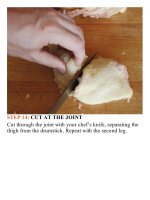The food lab better home cooking through science ( PDFDrive ) 434
Bạn đang xem bản rút gọn của tài liệu. Xem và tải ngay bản đầy đủ của tài liệu tại đây (133.31 KB, 2 trang )
Water
100%
103.2%
As you can see, while a plain chicken breast lost
about 17 percent of its moisture during cooking, a
brined breast lost only 10 percent. Salted breasts
came in just under brined breasts, at 11 percent.
Soaked in plain water, the breasts gained about 3
percent in weight prior to cooking, but all of that
extra water came right back out—water-soaked
breastsfarednobetterthanplainbreasts.
From this data, we know that salt is doing
something to help retain moisture, whether applied
through a brine or simply rubbed on the surface of
the breasts. How does it accomplish this? It’s the
sameassaltingasteakbeforeyoucookit:it’sinthe
shape of the proteins. In their natural state, muscle
cellsaretightlyboundwithinlongproteinsheaths—
this doesn’t leave much room for extra water to
collect in the meat. But as anyone who has ever
made sausages or cured meats knows, salt has a
powerfuleffectonmuscles(seehere).Asaltsolution
willeffectivelydenature(read:unravel)theproteins
that make up the sheath around the muscle bundles.
In their loosened denatured state, you can fit more
water into those muscles than in their natural state.
Even better, the denatured proteins in the sheaths
contract far less as they cook, squeezing out much
lessmoisture.
So, which method is better: brining or extended
salting? From the chart alone, you’d guess brining;
themeatretainsanentireextrapercentagepointof
moisture. But is this all good news? I can hear you
all now saying, no more dry pork, chicken, or
turkey? Sign me up! Not so fast. There’s a major
trade-offwhenitcomestobrining,andit’sgottodo
with flavor. You see, while your meat may end up
juicier, remember that much of the juice it’s now
holding on to is nothing more than tap water.This
can have a pronounced effect on the flavor of the
meat. With salting, on the other hand, all of the
juicesintherenaturallyoccurinthemeat.
I’ve repeated this test numerous times with
everything from turkey to pork chops and always
come to the same conclusion: salting and resting
yourmeatissuperiorineverywaytobrining.
CHICKENTEMPERATURE
ANDSAFETY
T
ake a look at the USDA’s basic cooking
guidelines, and you’ll see that they recommend
cookingfoodstohighertemperaturesthananyonein
their right mind would want to eat them at. They









